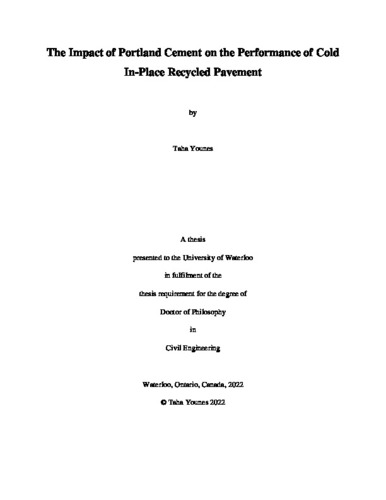| dc.description.abstract | In place recycling of existing asphalt pavement is a rehabilitation strategy, which the Ministry of
Transportation Ontario (MTO) adopted decades ago. Asphalt emulsion is the most common type
of bitumen stabilizing agent incorporated into recycled mixtures in Ontario. Active fillers such as
Portland cement, hydrated lime and fly ash can be added to a volume fraction of less than 1% to
the recycled mixtures to improve dispersion of the bitumen in the mixtures and to increase the
stiffness of the mixtures and the rate of strength gain. This study is a project of the Centre for
Pavement and Transportation Technology (CPATT) laboratory at the University of Waterloo in
partnership with the MTO and various industry partners in Ontario. Cationic Slow Setting
Emulsion (CSS-1H) and Anionic High Float Emulsion (HF-150) emulsions were mixed with
typical Reclaimed Asphalt Pavement materials (RAP), which are pulverized (HL8 and HL3) in the
CPATT laboratory at the University of Waterloo. To improve the dispersion of the bitumen in the
mixes and to increase the stiffness of the mixtures and the rate of strength gain, different
percentages of Portland cement (0%, 0.5%, 1.5% and 3%) were added to the mixes. Four mixes
were prepared. Mixture 1 (M1) was developed using the cationic slow setting emulsion-CSS-1H
that was mixed with a pulverized HL8 RAP material; for the second mixture (M2), the Anionic
High Float Emulsion (HF-150) was mixed with a pulverized HL8 RAP material. However, for the
third mixture (M3), the cationic slow setting emulsion-CSS-1H was mixed with pulverized HL3
RAP material, and for the fourth mixture (M4), the Anionic High Float Emulsion (HF-150) was
mixed with pulverized HL3 RAP material. These mixes were tested and evaluated using Indirect
Tensile, Dynamic Modulus, Fatigue and Thermal Stress Restrained Specimen Tests. Furthermore,
the moisture susceptibility was controlled by conditioning the specimens for 24 hours at 25 degrees
Celsius before testing. The results showed that increasing the percentage of Portland cement led
to an increase in strength. For the Cold In-Place Recycled Asphalt (CIR) mixes, the addition of
Portland cement increased the stiffness. For M1 and M2 mixes, there was a tradeoff relationship
between the stiffness and fatigue life. Adding amounts of Portland cement between 0.5% and 1.5%
to these mixes increased the stiffness significantly with only a small reduction in fatigue life. As
Portland cement was added to M3 and M4 mixtures, the stiffness increased until the cement content
reached 1.5%. Additions above 1.5% did not produce a noticeable increase in stiffness. Also, the
tensile strength and moisture resistance improved significantly with the addition of Portland
v
cement. However, the low-temperature fracture properties of the mixtures deteriorated due to
increased brittleness and the development of shrinkage cracks that caused the mixtures to fail at
higher temperatures and lower fracture stresses. In all cases, adding amounts of Portland cement
between 0.5% and 1.5% enhanced the stiffness, tensile strength, and moisture
susceptibility resistance of the mixes with only a small reduction in fatigue life. Finally, a classic
Maxwell model, a rheological model comprised of a spring and dashpot in a series of materials,
was used to simulate either the stress-strain behaviour of the material or the force-deformation
relationship of a test specimen. The model, once calibrated using the stress-strain data from a single
specimen fatigue test, accurately described the stress-strain histories for all tests. Features
described by the model included the stress-strain hysteresis loop shape, the relaxation of mean
stress to zero under controlled strain cycling and the decrease of stress range with cyclic straining.
The latter gave accurate predictions of the reduction of the initial stiffness to one-half its initial
value, which was used as the definition of failure. | en |

